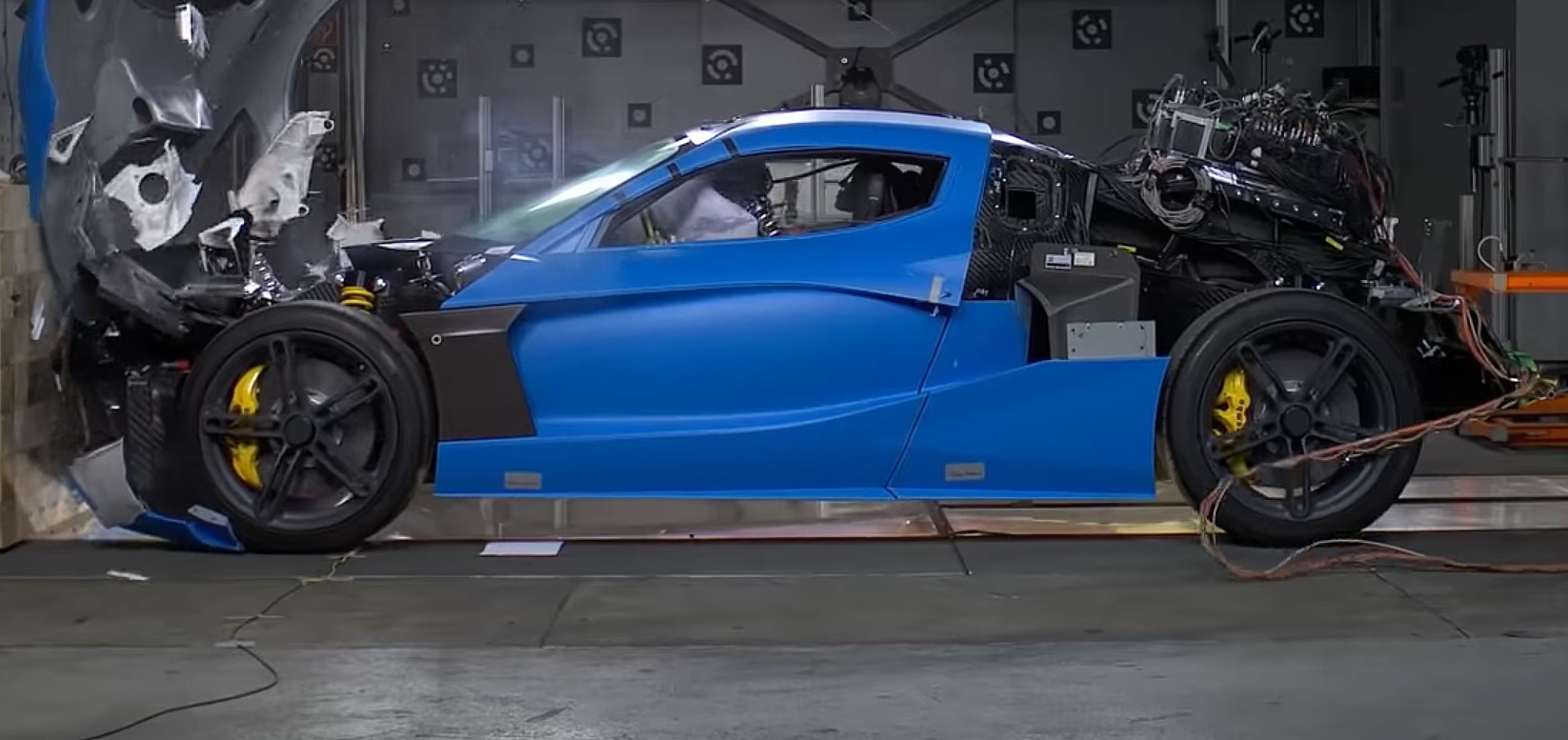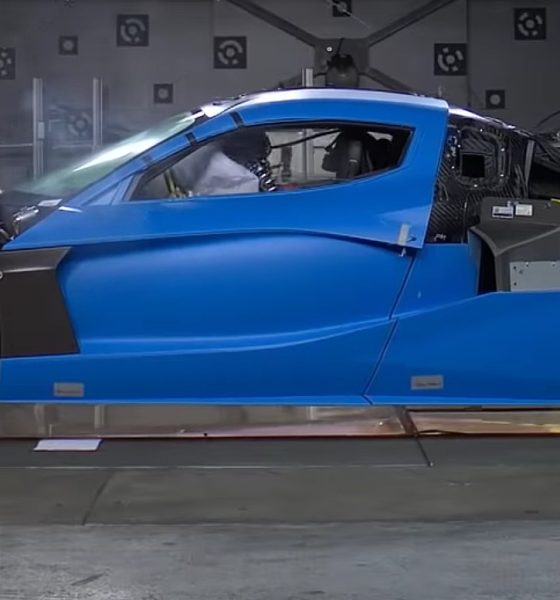Croatian electric sports car producer Rimac recently put its new C_Two hypercar through a series of rigorous crash tests in order to create an extremely safe hypercar that the company claims will cost around $2 million.
Research and development into the car’s safety was a focus of Rimac. The car has an anticipated top speed of 258 MPH (412 KMH), so the company has been especially focused on the safety of the driver and passengers in the event of a crash. “Our supercomputers are running 24/7 to improve the performance of our car for safety and stiffness,” Rimac’s Computer-Aided Engineer Gustavo Andrade said.
The C_Two is a marvel of electric vehicle engineering. Each of the vehicle’s wheels will operate with its own permanent-magnet synchronous motor, as well as its own gearbox. Each motor will be liquid-cooled. The 120 kWh battery will give owners around 400 miles of range as well. Rimac claims that the car can accelerate from a standstill to 100 KMH in 1.85 seconds, and also that the car completed two consecutive laps at the Nürburgring racetrack in Germany without any significant drop in performance.
Rimac’s C_Two hypercar has been in development for around three years and has undergone thousands of crash simulations on Rimac’s computers. Director of Vehicle Engineering Daniele Giachi said that it is crucial to generate detailed models of the vehicle before sending it to real-world testing. The cost of a production model of the vehicle is expected to be around €1.795 million, so it would not be effective or logical for Rimac to crash test with the C_Two. “The goal is to have the most perfect correlation between real and virtual testing in order to minimize the risk when you go to crash a prototype that costs one million Euros,” Daniele Giachi said.
The car has gone through a lengthy process with physical crash tests, starting with experimental prototypes. After testing them and coming up with the best options, they then choose on a single prototype body style to test, making adjustments to it frequently and finally deciding on a pre-production model that would be most advantageous to test.
There are obviously bumps in the road and unexpected difficulties when testing a new prototype, and the Rimac C_Two is no exception. “Nobody can promise one hundred percent success for the first time. Sometimes things go wrong,” Andrade said. During the first round of testing, an unexpected movement from the vehicle’s rail proved to be disastrous during testing. The team had to go back to the drawing board as none of the computer simulations predicted the error. The development team was able to recognize the error and produce a new prototype that would prevent it from happening.
Daniele Giachi noted that the company tends to test both virtual and real-world models excessively in order to produce the safest car possible. “Because many things can go wrong is the reason why we do many rounds of testing and because of this the team needs to be ready to react to this negative result with proactivity, finding new solutions for the issue we encountered.”
Watch Rimac’s crash test on its new C_Two below:

News
Tesla Cybercab tests are going on overdrive with production-ready units
Tesla is ramping its real-world tests of the Cybercab, with multiple sightings of the vehicle being reported across social media this week.

Tesla is ramping its real-world tests of the Cybercab, with multiple sightings of the autonomous two-seater being reported across social media this week. Based on videos of the vehicle that have been shared online, it appears that Cybercab tests are underway across multiple states.
Recent Cybercab sightings
Reports of Cybercab tests have ramped this week, with a vehicle that looked like a production-ready prototype being spotted at Apple’s Visitor Center in California. The vehicle in this sighting was interesting as it was equipped with a steering wheel. The vehicle also featured some changes to the design of its brake lights.
The Cybercab was also filmed testing at the Fremont factory’s test track, which also seemed to involve a vehicle that looked production-ready. This also seemed to be the case for a Cybercab that was spotted in Austin, Texas, which happened to be undergoing real-world tests. Overall, these sightings suggest that Cybercab testing is fully underway, and the vehicle is really moving towards production.
Production design all but finalized?
Recently, a near-production-ready Cybercab was showcased at Tesla’s Santana Row showroom in San Jose. The vehicle was equipped with frameless windows, dual windshield wipers, powered butterfly door struts, an extended front splitter, an updated lightbar, new wheel covers, and a license plate bracket. Interior updates include redesigned dash/door panels, refined seats with center cupholders, updated carpet, and what appeared to be improved legroom.
There seems to be a pretty good chance that the Cybercab’s design has been all but finalized, at least considering Elon Musk’s comments at the 2025 Annual Shareholder Meeting. During the event, Musk confirmed that the vehicle will enter production around April 2026, and its production targets will be quite ambitious.
News
Tesla gets a win in Sweden as union withdraws potentially “illegal” blockade
As per recent reports, the Vision union’s planned anti-Tesla action might have been illegal.

Swedish union Vision has withdrawn its sympathy blockade against Tesla’s planned service center and showroom in Kalmar. As per recent reports, the Vision union’s planned anti-Tesla action might have been illegal.
Vision’s decision to pull the blockade
Vision announced the blockade in early December, stating that it was targeting the administrative handling of Tesla’s facility permits in Kalmar municipality. The sympathy measure was expected to start Monday, but was formally withdrawn via documents sent to the Mediation Institute and Kalmar Municipality last week.
As noted in a Daggers Arbete report, plans for the strike were ultimately pulled after employer group SKR highlighted potential illegality under the Public Employment Act. Vision stressed its continued backing for the Swedish labor model, though Deputy negotiation manager Oskar Pettersson explained that the Vision union and IF Metall made the decision to cancel the planned strike together.
“We will not continue to challenge the regulations,” Petterson said. “The objection was of a technical nature. We made the assessment together with IF Metall that we were not in a position to challenge the legal assessment of whether we could take this particular action against Tesla. Therefore, we chose to revoke the notice itself.”
The SKR’s warning
Petterson also stated that SKR’s technical objection to the Vision union’s planned anti-Tesla strike framed the protest as an unauthorized act. “It was a legal assessment of the situation. Both for us and for IF Metall, it is important to be clear that we stand for the Swedish model. But we should not continue to challenge the regulations and risk getting judgments that lead nowhere in the application of the regulations,” he said.
Vision ultimately canceled its planned blockade against Tesla on December 9. With Vision’s withdrawal, few obstacles remain for Tesla’s long-planned Kalmar site. A foreign electrical firm completed work this fall, and Tesla’s Careers page currently lists a full-time service manager position based there, signaling an imminent opening.
News
Tesla Semi program Director teases major improvements

Tesla Semi Program Director Dan Priestly teased the major improvements to the all-electric Class 8 truck on Thursday night, following the company’s decision to overhaul the design earlier this year.
Priestley said he drove the Semi on Thursday, and the improvements appear to be welcomed by one of the minds behind the project. “Our customers are going to love it,” he concluded.
Just drove the redesigned Semi. Our customers are going to love it. https://t.co/KZ88sf1CDL
— Dan Priestley (@danWpriestley) December 19, 2025
The small detail does not seem like much, but it is coming from someone who has been involved in the development of the truck from A to Z. Priestley has been involved in the Semi program since November 2015 and has slowly worked his way through the ranks, and currently stands as the Director of the program.
Tesla Semi undergoes major redesign as dedicated factory preps for deliveries
Tesla made some major changes to the Semi design as it announced at the 2025 Annual Shareholder Meeting that it changed the look and design to welcome improvements in efficiency.
Initially, Tesla adopted the blade-like light bar for the Semi, similar to the one that is present on the Model Y Premium and the Cybertruck.
Additionally, there are some slight aesthetic changes to help with efficiency, including a redesigned bumper with improved aero channels, a smaller wraparound windshield, and a smoother roofline for better aero performance.
All of these changes came as the company’s Semi Factory, which is located on Gigafactory Nevada’s property, was finishing up construction in preparation for initial production phases, as Tesla is planning to ramp up manufacturing next year. CEO Elon Musk has said the Semi has attracted “ridiculous demand.”
The Semi has already gathered many large companies that have signed up to buy units, including Frito-Lay and PepsiCo., which have been helping Tesla test the vehicle in a pilot program to test range, efficiency, and other important metrics that will be a major selling point.
Tesla will be the Semi’s first user, though, and the truck will help solve some of the company’s logistics needs in the coming years.










